Notable Sales: Giovanni Rota
Giovanni Rota, a native of Cremona, was descended from the wife of Nicolò Amati and was adopted as an apprentice to Lorenzo Storioni in 1787. There he worked until 1792, and in Storioni’s house he would also have come into contact with Nicola Bergonzi, the grandson of Carlo Bergonzi, who lived there from 1790 to 1795.
The principal Cremonese makers of this period (Storioni, Bergonzi and G.B. Ceruti) were largely self-taught. If, as Dmitry Gindin speculates, Rota spent his career as a professional workshop apprentice to these Cremonese makers, this would account for the rarity of violins attributed to him as an independent maker.
Rota’s instruments were inspired by the makers around him, rather than by a burning creativity inside him, but he was a fine craftsman, and his work is clean, with neatly carved scrolls and f-holes and rather broad purfling. His choice of materials is typical of the late Cremonese makers (see the Storioni-like wood of the circa 1800 violin), but his distinctive hand is recognisable in his few surviving works, even if his deviations from the patterns of his master are not dramatic. Rota occasionally produced violas, such as the example from 1809 and also cellos, which are of the small dimensions favoured by Storioni and Ceruti.
(b Cremona,1767; d c1810)
Giovanni Rota, a native of Cremona, was descended from the wife of Nicolò Amati and was adopted as an apprentice to Lorenzo Storioni in 1787. There he worked until 1792, and in Storioni’s house he would also have come into contact with Nicola Bergonzi, the grandson of Carlo Bergonzi, who lived there from 1790 to 1795.
The principal Cremonese makers of this period (Storioni, Bergonzi and G.B. Ceruti) were largely self-taught. If, as Dmitry Gindin speculates, Rota spent his career as a professional workshop apprentice to these Cremonese makers, this would account for the rarity of violins attributed to him... Read more
26 April 2021 - Dilworth, John
The Evolution of Violin Making from 16th-20th Century Part VI
We offer buyers and sellers a bespoke private sale service, sourcing exceptional instruments and bows and matching them with the most discerning buyers.
More InformationTim Ingles and Paul Hayday will offer an initial evaluation of the authenticity and value of your instrument or bow to recommend an auction estimate and reserve price.
Enquire
Tim Ingles and Paul Hayday will offer an initial evaluation of the authenticity and value of your instrument or bow. At this stage, the assessment is free and without obligation. In the first instance, we suggest submitting good-quality images to us, preferably by email to info@ingleshayday.com or by completing the valuation form.
Read more